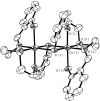Incorporation of thiolate donation using 2,2'-dithiodibenzaldehyde: complexes of a pentadentate N2S3 ligand with relevance to the active site of Co nitrile hydratase
- PMID: 17698201
- PMCID: PMC2278241
- DOI: 10.1016/j.jinorgbio.2007.06.042
Incorporation of thiolate donation using 2,2'-dithiodibenzaldehyde: complexes of a pentadentate N2S3 ligand with relevance to the active site of Co nitrile hydratase
Abstract
The use of 2,2'-dithiodibenzaldehyde (DTDB) as a reactant for incorporating thiolate donors into the coordination sphere of a transition metal complex without the need for protecting groups is expanded to include the synthesis of complexes with pentadentate ligands. The ligand N,N'-bis(thiosalicylideneimine)-2,2'-thiobis(ethylamine) (tsaltp) is synthesized at a cobalt center by the reaction of DTDB with a Co complex of thiobis(ethylamine). The resulting Co complexes are thus coordinated by the N(2)S(3) pentadentate ligand through two imine N atoms, two thiolate S atoms, and one thioether S atom. A dimeric, bis-thiolate-bridged complex (1) is isolated and converted to a monomeric CN adduct (2) by treatment with KCN. The N(2)S(3) coordination environment provided by the tsaltp ligand is similar to that provided by the protein donors at the active site of the nitrile hydratase enzymes, with 2 being the first octahedral Co complex reported with such a coordination sphere.
Figures
References
-
- Nagasawa T, Nanba TH, Ryuno K, Takeuchi K, Yamada H. Eur J Biochem. 1987;162:691–8. - PubMed
-
- Odaka M, Noguchi T, Nagashima S, Yohda M, Yabuki S, Hoshino M, Inoue Y, Endo I. Biochem Biophys Res Comm. 1996;221:14650. - PubMed
-
- Odaka M, Fujii K, Hoshino M, Noguchi T, Tsujimura M, Nagashima S, Yohda M, Nagamune T, Inoue Y, Endo I. J Am Chem Soc. 1997;119:3785–91.
-
- Nagasawa T, Ryuno K, Yamada H. Biochem Biophys Res Comm. 1986;139:1305–12. - PubMed
-
- Nelson MJ, Jin J, Turner IM, Grove G, Scarrow RC, Brennan BA, Que L. J Am Chem Soc. 1991;113:7072–3.
Publication types
MeSH terms
Substances
Grants and funding
LinkOut - more resources
Full Text Sources
Miscellaneous



